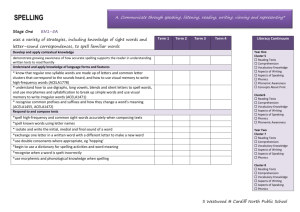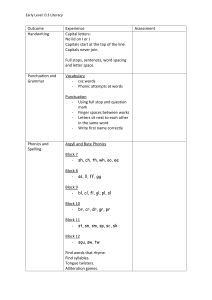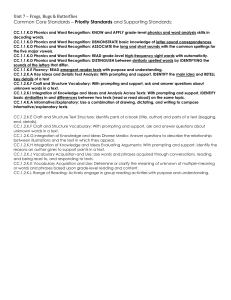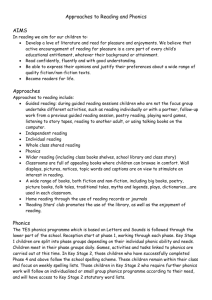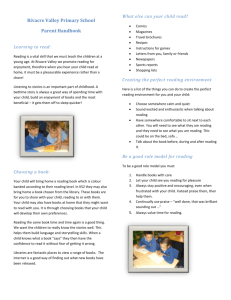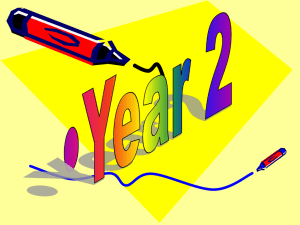St Thomas of Canterbury RC Primary School, Salford
advertisement
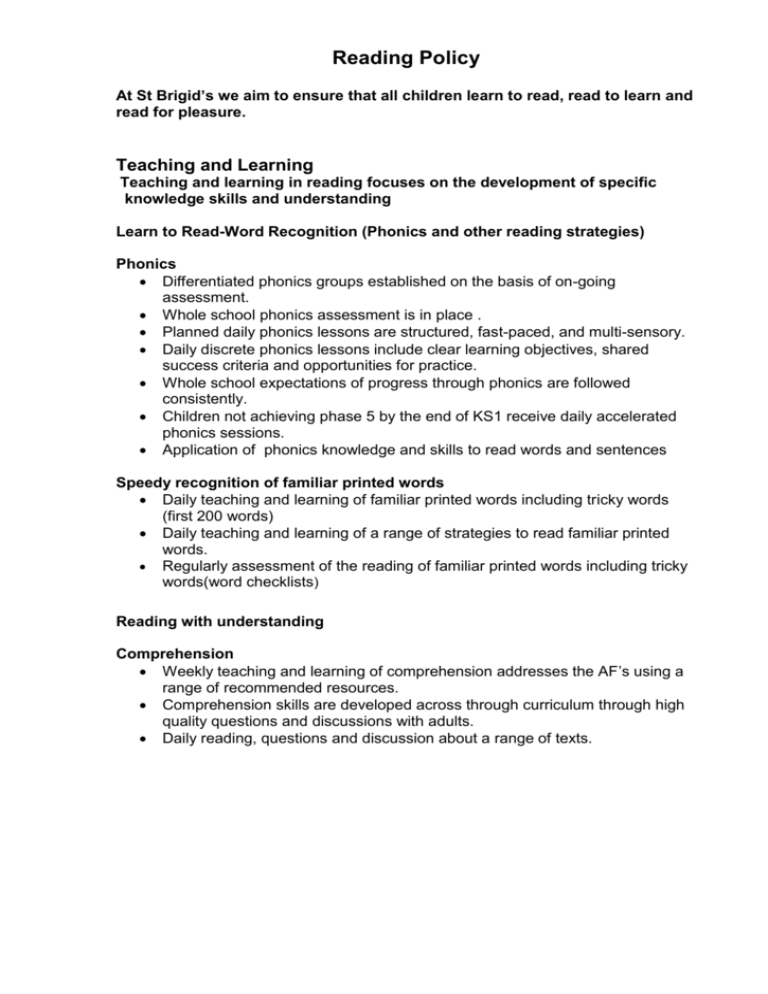
Reading Policy At St Brigid’s we aim to ensure that all children learn to read, read to learn and read for pleasure. Teaching and Learning Teaching and learning in reading focuses on the development of specific knowledge skills and understanding Learn to Read-Word Recognition (Phonics and other reading strategies) Phonics Differentiated phonics groups established on the basis of on-going assessment. Whole school phonics assessment is in place . Planned daily phonics lessons are structured, fast-paced, and multi-sensory. Daily discrete phonics lessons include clear learning objectives, shared success criteria and opportunities for practice. Whole school expectations of progress through phonics are followed consistently. Children not achieving phase 5 by the end of KS1 receive daily accelerated phonics sessions. Application of phonics knowledge and skills to read words and sentences Speedy recognition of familiar printed words Daily teaching and learning of familiar printed words including tricky words (first 200 words) Daily teaching and learning of a range of strategies to read familiar printed words. Regularly assessment of the reading of familiar printed words including tricky words(word checklists) Reading with understanding Comprehension Weekly teaching and learning of comprehension addresses the AF’s using a range of recommended resources. Comprehension skills are developed across through curriculum through high quality questions and discussions with adults. Daily reading, questions and discussion about a range of texts. Teaching and Learning Approaches A range of teaching and learning approaches are used to ensure that all children become the best readers possible Whole class reading A range of high quality reading materials are read with the whole class in a range of curriculum contexts. Whole class literacy planning includes the explicit teaching and learning of reading.. Children are read aloud to daily (e.g. texts linked to year group author). Group reading A whole school weekly planning and assessment format is used , which includes clear learning outcome linked to book bands/ levels,. Each child has at least one group reading session a week with an adult. A range of reading resources are used (real books, scheme books, decodable texts, ICT. Bookmark/stickers are used to reward progress in reading. Independent reading Daily opportunities for non-adult led independent reading tasks including reading for pleasure. All reading activities have a clear learning outcomes linked to a range of AF’S, Reading activities are recorded in reading journals .They provided evidence of and progress in reading Individual reading Individual (1.1) reading records are completed for each child. Whole school expectation that children bring their book and reading record to school every day. Children who do not read at home are identified and read with daily. Reading buddies system is established. Planning Effective planning of teaching and learning is in place. Whole school literacy planning used. Planning includes targets, learning objectives and success criteria Planning takes place in key stage teams when possible.. Planning is evaluated regularly Home Learning There is effective communication with parents and carers about how the school teaches reading and how they can support their child’s learning. Home /school reading record sent home with home reading books. Parents supported and encouraged to write in reading record weekly Books matched to children’s reading level are taken home daily. Children to be provided with a range of texts (including non-fiction, fiction, picture books and poetry) Books are changed at least once a week with an adult and Additional reading activities are sent home as required ‘Parents supporting reading’ events. Information sessions for parents Parents invited to observe reading in classrooms Reader of the week identified and rewarded at celebration assemblies. The Learning Environment A love of reading is actively encouraged and promoted Class reading areas Class collections – fiction, non-fiction, ICT and big texts are available to all classes, selected from the library half termly. A selection of key texts are attractively displayed , changed regularly and linked to theme/author/topic. ‘Special/new ‘book boxes are available in all classes. ‘Attractive book corners are in place, used daily and developed each term . Children have access to appropriate ICT resources (e.g. laptops, ipads and CD’s). Reading displays In classes/around school-posters/pictures/authors/reviews Class Author focus –changed half termly Reading events Books week Family events- Book sales Reading challenges (Dive into Books!) Book clubs targeting different groups School library All children have the opportunity visit the school library at least once a week. Community Library All classes visit the community library half termly Interventions Interventions are provided for younger and older struggling readers to meet their learning needs. The following reading interventions are used : Phonics, P-L1 ,L1-L2 Intervention, L2-L3 Intervention, Children not achieving age related expectations in reading, including those with SEN are identified and targeted for extra support. Adults are identified and trained to deliver interventions. Interventions are planned and evaluated weekly. A range of appropriate resources are used. Teachers liaise with intervention staff to ensure that there are strong links between intervention work and teaching in mainstream classes. CPD CPD is provided to ensure that all teaching staff are competent teachers of reading. Relevant CPD is provided regularly for all staff on whole school issues (e.g. phonics, comprehension) and according to individual need. CPD is provided by the literacy leader through regular staff/KS meetings, peer coaching and attending citywide training. All teaching staff to have reading guidance files to ensure there is a consistent approach to the teaching, learning and assessment of reading. Achievement There is regular assessment of teaching and learning in reading to ensure all pupils are making good progress and to plan next steps in learning. Teacher Assessment EYFSP Phonics checklists Tricky word lists Book bands Reading targets Reading planning and assessment sheet Observations Lesson evaluations Reading journals Marking and feedback Test base questions Summative Assessment EYFSP Year One phonics screen Rising Stars reading assessment KS1 reading test Optional KS2 reading tests KS2 reading tests APP group grids P levels Tracking A whole school system for tracking pupil’s progress is in place Pupils progress levels in reading are recorded termly Progress in writing is analysed termly/discussed at pupil progress meetings and next steps for learning identified and shared with children. Resources A range of high quality multi sensory and age appropriate resources are used to support teaching and learning in reading. Whole school Phonics Programme ‘Real ‘ texts-fiction/non fiction Range of levelled scheme texts Phonically decodable levelled texts High interest/low reading level texts Cross curricular texts Electronic texts Word reading activities Comprehension activities Leadership and Management The Role of the Literacy Subject Leader Support and advise all staff on teaching/ learning and assessment Provide CPD Model good practice. Monitor and give feedback on planning, teaching/learning, home reading, and progress Implement and monitor interventions. Write and update action plans/policies and contribute to the school development plan. Purchase and manage a range of high quality literacy resources. Analyse assessment data and identify next steps. Work with governors, parents/carers and the wider community. Keep updated on current developments through attending training. Work in partnership with Literacy Subject leaders in other schools to share/develop best practice. Ann Carney Oct 2012

